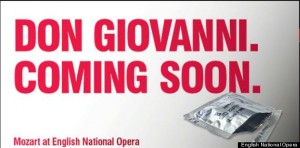Is “ENO” Short for ENOUGH with the Double Standard Against Arts Marketing?
Opera, an art form that has been around for centuries; steeped in history and revered by many, has never been a catch all activity. Much of the time it’s common to hear the phrase, “You either love it or hate it” when brought up in conversation. Aside from those folks who are not liable to change their views because of a singular dislike for opera’s aural aesthetic -something that really can’t be changed- much like the texture of food, at least some in the ‘dislike’ camp are liable to attribute their attitudes to a feeling of opera being stuffy, boring, for ‘old people…’ any number of these fact-less descriptors.
For anyone running an opera house, this is a basic marketing problem, connected with advertising and public relations. How a company portrays and describes its own work to the general public directly affects and influences how potential audience members feel about the thought of either attending or not attending a performance. There are different things that have to be accomplished depending on who is viewing an ad or preview. For those that have never been to an opera, they need a complete introduction. For someone who has been to an opera but perhaps never to an opera by XYZ composer, they need appeal to the different musical style and storytelling.
Either way, in both cases, the company in question still needs to make their productions sound exciting and attractive. After all, if there’s no desire, there will be no person in the chair come curtain time. Well, past any strategies to just put the name of the opera with a dramatic moment frozen in photo form, possibly with an ornate and eye-catching costume, there’s only so much a picture can convey and if you don’t know a story or think a genre to be universally stuffy, one fancy costume and an open mouthed opera singer isn’t going to project anything to convince you otherwise.
 |
| The English National Opera’s Advert for their upcoming revival of Don Giovanni, premiering October 17th (Cit. Huffington Post) |
Now we go back to the original statement of there being an issue. Though a minimalist and stark advertisement this is, it manages to put forth provocative implications and a slangy double entendre. Instantly up for controversy, some might find this strategy too racy and or inappropriate -either for the sake of younger people or for the sake of this delicate and refined art form.
At present though, it seems commenters on other sites have little but praise for refreshment and cleverly retrained realism vis a vie this ad. One such comment that easily sums up the benefits comes from a reader named “Average Employed Woman” on the LA Times website, which is interesting, given that the US can often find itself on the more conservative side of things when it comes to things like nudity and open talk of sexuality, when compared with their European counterparts:
“…I thought the ad was hilarious. Let’s face [it:] DG is not exactly a family friendly storyline, nor are most opera themes when you think about it. It’s the opera goers responsibility to decide for themselves whether they are too sensitive for the material presented…and for heaven sakes parents[:] KEEP THE LITTLE TYKES AT HOME on opera night. They can go to more family friend[ly] productions during a matinee. I get sick of these parents who seem to think kids have to be everywhere when it’s clear the venue or event may not be appropriate for someone that young…and I don’t necessarily mean because of sexually oriented material. No kids should be out past their bedtimes anyway… “
In my honest opinion, one Average Employed Woman hit the nail on the head.
Three things I have to say for the hypothetical scenarios of younger-than-ideal people seeing this advertisement:
I understand opera is an acquired taste. I understand much of the time it can require a bit of education; whether formal or informal through friends that take you along. Yet I’m not afraid to propose that those likely to be critical of the ENO’s newest attempt at drilling up interest are probably not handing down the same judgement on other ‘child-questionable’ aspects in their lives.
The truth is, opera can have many benefits for young children if they take to it from an early age. Exposure to everything from foreign language to acting, singing, musical form, staging, and even a bit of practice in public manners and patience. If a parent wants these things for their kids without the elements of sexual conquest or extreme violence, then just be selective about which opera stories either sidestep those things altogether or have less overt symbolism that will completely go over a child’s head and can be explained with a more innocent interpretation until they’re older. (FYI: Knowing a family has interest in exploring a show, any opera house would probably be ecstatic to suggest productions based on preference – just call!) Other franchises or characters that depict content just as easily subject to controversy don’t come under as much fire because they are more ingrained into cumulative popular culture and accepted for their longstanding nostalgia.
However, if we’re playing fair, Mozart and his compositions were around far before Stan Lee, Bob Kane and Bill Finger were…

Leave a Reply